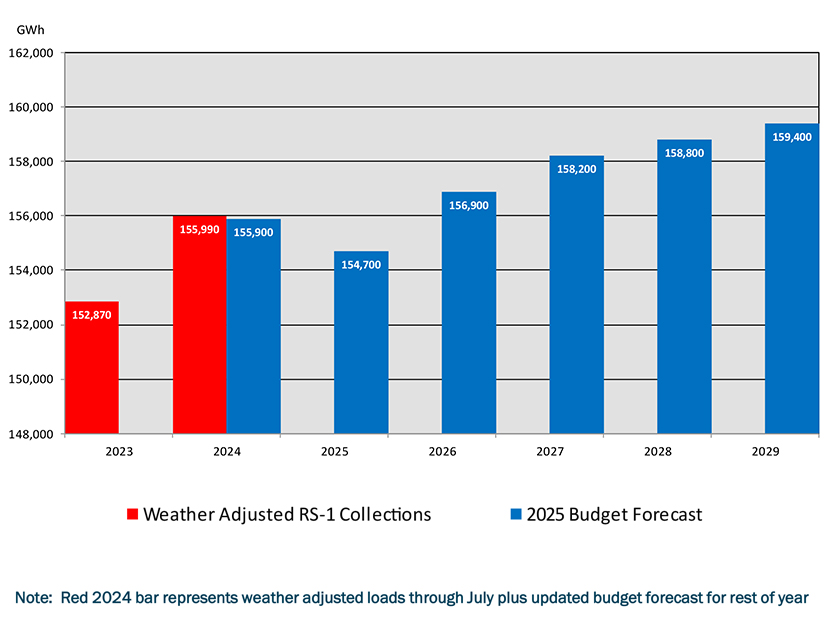
NYISO on Sept. 6 presented its $204 million draft budget for 2025 to the Budget and Priorities Working Group, with an administrative rate of $1.319/MWh based on a 154,700-GWh transmission throughput.
The proposed budget is a 4.72% increase over 2024’s $194.8 million. The proposed Rate Schedule 1 surcharge — the ISO’s administrative fee to recover its operating costs from members — is nearly 3% higher than this year’s $1.281/MWh. The surcharge is billed to all users of transmission lines based on the calculations set forth in NYISO’s tariff.
“The increase in the revenue requirement for 2025 relative to 2024 is $9.2 million, which is about 4.7%,” NYISO CFO Cheryl Hussey told stakeholders. “The projected 2025 megawatt-hour throughput is an increase of 2.6 million MWh, which is an increase of 1.7% compared to 2024.”
Hussey reported that NYISO is projecting a 2024 budget surplus because of overcollections under RS1 and spending being under budget. The ISO is therefore proposing an RS1 carryover of $3 million into the 2025 budget. This would reduce the impact of 2025 cost increases by approximately 2 cents/MWh, Hussey said. She also explained that if the carryover were not used to decrease the cost of RS1, it would be used to pay down debt.
“For example, in 2023, we used $5 million as a carryover, and then the balance we used to pay down debt,” Hussey said. “In recent years, we’ve used a surplus to pay down debt. 2023 was the first time in a number of years that we proposed a carryover.”
Debt servicing was projected to increase in 2025 to $7 million, an increase of about $4.8 million.
Mark Younger, of Hudson Energy Economics, requested that NYISO provide more information about the kinds of debt the ISO had currently so stakeholders could see whether paying off high-interest and variable-interest loans or a carryover would be a better use of funds. Hussey said NYISO might be able to present something to address that at future meetings.
“Why are your debt services going up?” asked Amanda De Vito Trinsey of Couch White, representing New York City.
Hussey explained that in 2024 and 2025, NYISO was borrowing more money to pay for its increased project portfolio and infrastructure capital needs. In 2024, the ISO had borrowed $37 million to pay for its projects.
“Obviously, the more money we borrow, we need to pay that back, and that leads to increased debt service costs in future years,” Hussey said. “I’ll point out that we are proposing to borrow $37 million again in 2025 to cover the cost of the project portfolio.”
Hussey ran through more drivers of the cost increase, including a cost-of-living adjustment for its Market Monitoring Unit. Salary and benefits are also increasing between 4 and 6%, with 19 new staff positions being added, primarily to work on FERC orders 2023 and 1920 compliance and the Coordinated Grid Planning Process.
“We always have to keep in mind that we maintain our salaries as competitive as compared to the market and as best we can limit inequities between certain positions that we have here at the ISO that should be placed in similar levels,” Hussey said.
One stakeholder asked whether the budget was based on full staffing or the expected vacancy rate for NYISO. Hussey said that the vacancy rate was expected to be around 6% and that the budget was based on that lower number. She explained that NYISO was balancing its staffing needs against normal churn and imperfect replacement of departing employees.
The final big line item was computer services. NYISO projects it will spend $3.9 million on computer services, up $1.5 million from the previous year. This is primarily for upgrades, enterprise software subscription costs and increased Amazon Web Services costs.
Forecasts Through 2029
Max Schuler, an economic analyst for NYISO, presented the RS1 forecast through 2029.
The RS1 rate is based on net load, billable exports, wheel-throughs and incremental supply. NYISO anticipates increased load driven by large load interconnections, electric vehicles, heating electrification and general economic growth.
“Another important factor is the weather, which is most significant during the winter months for the exports and general system conditions and balance with external control areas,” said Schuler, while also noting that climate change is expected to lead to increased net load because of warmer weather in the summer.
Schuler said that by 2029, the total throughput is expected to reach 159,400 GWh. Balancing the expected increases in net load are increased behind-the-meter solar, energy efficiency and billable exports. BTM solar and EE are forecasted to cut RS1 by 0.6 and 1.3%/year, respectively.
Net load is forecasted to dip slightly in 2025 to 147,850 GWh from this year’s estimate of 148,580 GWh. After next year, NYISO thinks that the net load will gradually increase to 152,320 GWh by 2029.
Next Steps
The Board of Directors will review a “high-level” summary of the draft budget at its meeting Sept. 17, with the Management Committee reviewing it at its meeting Sept. 25.
Following more Budget and Priorities Working Group meetings, the MC is expected to vote on the budget Oct. 31 and the board Nov. 19.



